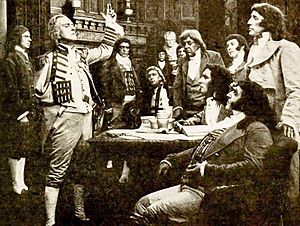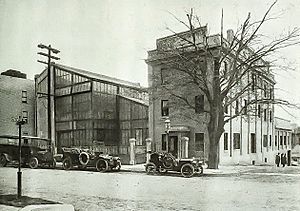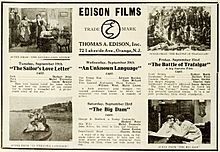The Battle of Trafalgar (1911 film) facts for kids
The Battle of Trafalgar is a 1911 American silent film. It's a type of movie called a docudrama, which means it tells a true story in a dramatic way. This film showed the famous 1805 victory of the British Royal Navy. They fought against the combined navies of France and Spain. This big battle happened during the Napoleonic Wars.
The movie also showed the death of the British leader, Vice-Admiral Horatio Nelson. He was a very important figure in that huge sea battle. This short film, called a "one-reeler", was directed by J. Searle Dawley. It was made by Thomas A. Edison, Inc.. The main actor was Sydney Booth, who played Admiral Nelson. Other actors included Herbert Prior, James Gordon, Charles Ogle, and Laura Sawyer. Sadly, this film is now lost, meaning no copies are known to exist today.
Contents
What the Movie Was About
This movie was called a "powerful historical drama" when it came out in 1911. It told the story of the famous battle near Cape Trafalgar, off the coast of Spain. This battle took place on October 21, 1805.
Nelson's Plan and Preparations
The film started by showing Lord Nelson (played by Sydney Booth) in London. This was weeks before the battle. He was at the Board of Admiralty, which was like the navy's headquarters. There, he showed his amazing plan to attack the French fleet. The French ships were supported by their Spanish allies. After talking about his brave plan, Nelson and his officers raised their glasses. They made a toast to King George III. They also wished for Britain's success against Emperor Napoleon Bonaparte's navy.
Life Aboard the Ship
The movie then moved to scenes at sea. It showed HMS Victory, which was Nelson's main ship. It was the day before the battle. Officers were writing letters, maybe their last ones, to their families and loved ones. Lieutenant Prescott (Herbert Prior) was shown writing to his fiancée (Laura Sawyer). She appeared as a beautiful vision.
The Battle Begins
The next day, the film showed Nelson writing in his diary one last time. Later, on the Victory, he said goodbye to Captain Hardy (James Gordon) and other officers. This happened when they saw the long line of enemy ships far away.
Then, the film showed a "splendidly portrayed" moment. Signal flags were raised high. They sent Nelson's simple but inspiring message to all the British crews: "England expects that every man will do his duty". After this, the ship's decks were cleared for action.
Fighting and Nelson's Fate
The movie then showed the battle itself. There was "the firing of the guns" and "ships caught on fire." It also showed close-up views of the damaged Victory. While the battle raged, Nelson and Hardy walked calmly on the quarter deck. They were giving commands.
Suddenly, Nelson fell to his knees. He was hit by a musket ball. A sniper on the nearby French ship Redoubtable had shot him. Nelson was badly wounded. He was quickly carried below deck to the ship's cockpit. In the film's final scenes, which were very grand and sad, the brave admiral died. But before he died, Hardy brought him good news. The British fleet had completely defeated Napoleon's French and Spanish fleet.
Main Actors
- Sydney Booth played Admiral Lord Nelson.
- James Gordon played Captain Thomas Hardy.
- Herbert Prior played Lieutenant Prescott.
- Charles Ogle played William Beatty, the ship's doctor on HMS Victory.
- Laura Sawyer played Lieutenant Prescott's fiancée.
How the Movie Was Made
The movie was filmed in New York City at Edison Studios. This studio was in the Bronx. They built sets that looked like parts of the decks on HMS Victory.
The people who played the crewmen on the British and French ships were extras. These were local residents from the Bronx. They were quickly gathered by the studio.
In 1917, an actor named Marc McDermott remembered a funny mistake. One of these inexperienced extras, or "supers", made a big error in a scene. This forced the director, J. Searle Dawley, to film the whole combat scene again days later.
Dawley had been asking the extras to show lots of excitement. After many practice runs, he finally told them to start filming. A few days later, the scene was shown in the studio's dark room. That's when Dawley was shocked. He saw an eager extra, standing on the quarterdeck, pick up a papier-mache anchor. This anchor was supposed to weigh about a ton! With one hand, the extra threw it over the side. There was nothing to do but film the whole scene again. But that eager extra wasn't in the new filming.
Why the Film is "Lost"
A "lost film" means that no copies of the movie are known to exist anymore. This film is not found in major film collections. These include the Library of Congress or the UCLA Film Archives. So, it is believed to be lost forever.
A big fire happened at Edison's Bronx studios on March 28, 1914. This fire destroyed many sets, costumes, equipment, and "many moving picture feature films." It's very likely that any copies of The Battle of Trafalgar stored there were lost in that fire.
Other Films About Trafalgar
There were other silent films made later that also showed the Battle of Trafalgar. These should not be confused with this 1911 Edison movie. Two of these later films were much longer and more detailed British movies.
One was called Nelson; The Story of England's Immortal Naval Hero. It was a two-hour biopic (a movie about someone's life) from 1918. It starred Donald Calthrop. The other silent film was also a biopic, simply called Nelson. It was released in 1926 and starred Cedric Hardwicke. Both of these British films still exist today. They both have scenes of the 1805 battle. These scenes likely looked similar to some parts of the Edison version. They used simple special effects, like tiny models of warships and painted ship shapes. They also used small explosions and close-up camera shots to make it look like fleets were fighting.




